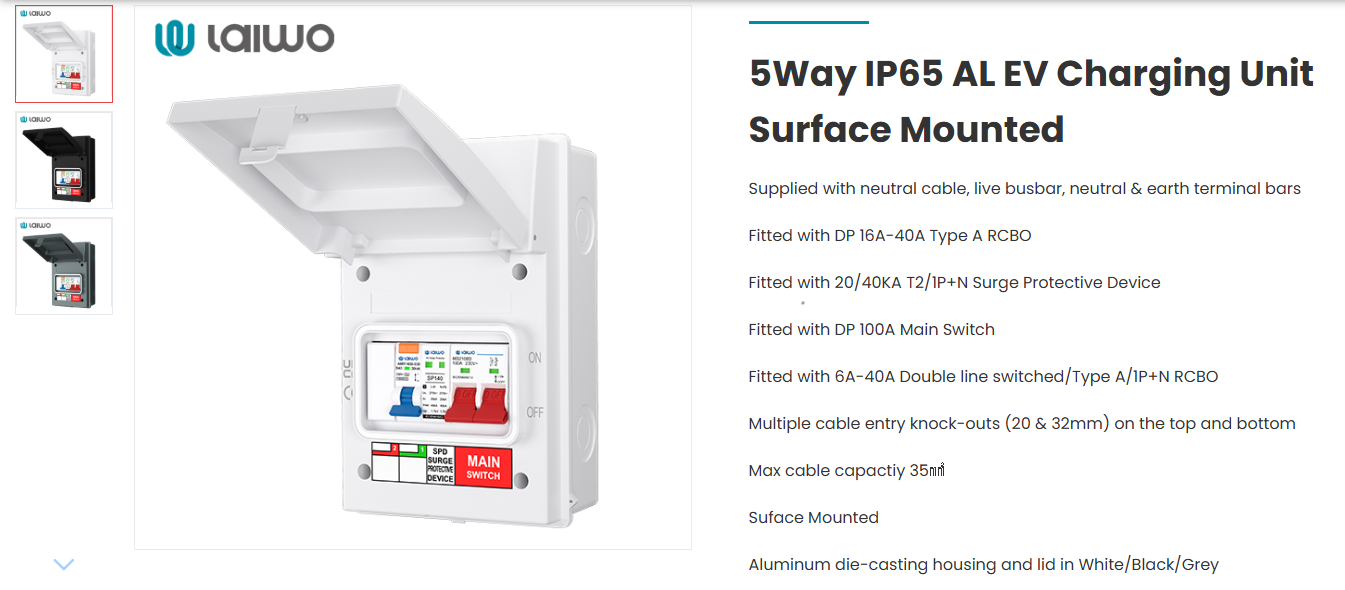
As electric vehicles (EVs) dominate roads, homeowners and businesses must adapt their electrical systems to support this green revolution. Central to this upgrade is the EV charger consumer unit, a specialized distribution board designed to handle the unique demands of EV charging. This guide unpacks everything you need to know—from how these units work to choosing the optimal setup for your needs.
An EV charger consumer unit is a dedicated electrical panel that distributes power specifically to an electric vehicle charger. Unlike standard consumer units, which manage general household circuits, these units are engineered to handle high, sustained loads—typically 7kW to 22kW—required for EV charging. Key features include:
Surge Protection Devices (SPDs): Shield against voltage spikes caused by grid fluctuations.
RCBOs (Residual Current Breakers with Overcurrent Protection): Combine earth leakage and overload protection.
Isolation Switches: Allow safe maintenance without cutting power to the entire property.
These units can be installed as a secondary consumer unit linked to the main board or as a standalone garage consumer unit for EV charger setups.
Learn More:
Distribution Boards: A Comprehensive Guide for Professionals and Consumers
How to Wire a Garage Consumer Unit: A Comprehensive Guide
EV chargers draw significant power over extended periods. A standard consumer unit may overheat, risking fire hazards. Dedicated EV charger consumer units mitigate this with:
Thermal Management: Robust components rated for continuous load.
Enhanced Insulation: Reduces arc flash risks in high-current environments.
UK wiring regulations (BS 7671) and IEC standards mandate dedicated circuits for EV chargers. Installing a consumer unit for EV charger ensures compliance, avoiding penalties or voided insurance.
With EVs evolving, a 3 phase EV charger consumer unit supports faster charging (up to 22kW) and scalability for multiple vehicles.
Dedicated units minimize voltage drop, ensuring optimal charging speeds.
Main Switch: Isolates the unit from the power supply.
RCBOs/RCDs: Detect earth faults (e.g., current leakage to the EV chassis) and trip within milliseconds.
MCBs (Miniature Circuit Breakers): Protect against overloads (e.g., a 32A MCB for a 7kW charger).
SPDs: Absorb surges from lightning or grid switching.
Learn More:
Understanding the difference between MCB RCCB and RCBO
What is the difference between a circuit breaker and a circuit protector?
Electricity flows from the main consumer unit to the EV charger consumer unit via a cable from consumer unit to EV charger (e.g., 6mm² twin and earth for 32A circuits).
The RCBO monitors for faults. If detected, it cuts power to the charger.
SPDs divert excess voltage to the earth, protecting the charger’s electronics.
Pro Tip: For outdoor setups, use an external consumer unit for EV charger with IP65-rated enclosures to withstand weather.

A garage consumer unit for EV charger consolidates charging and workshop circuits. Use 10mm² cable for runs exceeding 15 meters to prevent voltage drop.
A 3 phase EV charger consumer unit delivers up to 22kW, perfect for commercial fleets or rapid home charging. Requires a 5-core cable (L1, L2, L3, N, PE).
Outdoor consumer units for EV chargers feature weatherproof casings and lockable doors. Pair with Type B RCDs for enhanced fault detection.
A secondary consumer unit for EV charger is linked to the main board via a 40A–100A supply. Ideal for homes with limited space in the primary unit.
Check if your main board has spare capacity. If not, a consumer unit ev charger upgrade may be needed.
Verify earthing systems (TN-S, TN-C-S, or TT) to select compatible RCD types.
Best cable from consumer unit to EV charger: 6mm² for 32A single-phase; 16mm² for 3-phase 32A.
Use armored cables (SWA) for underground or outdoor runs.
Fix the unit near the charger, ensuring ventilation.
Connect the supply cable to a dedicated MCB in the main board.
Terminate live (brown), neutral (blue), and earth (green/yellow) wires to the unit’s terminals.
Link the EV charger via a Type 2 connector, adhering to IEC 62196 standards.
Perform insulation resistance and earth fault loop tests.
Issue an Electrical Installation Certificate (EIC) for compliance.
Warning: Always hire a certified electrician for connecting EV charger to consumer unit—DIY errors can void warranties or cause fires.
Single-Phase: Sufficient for 7kW chargers (e.g., home use).
Three-Phase: Opt for a 3 phase EV charger consumer unit if targeting 11kW–22kW.
Indoor Units: IP40 rating.
Outdoor Units: IP65 or higher.
Look for BS EN 61439-3 certification for distribution boards and UKCA/CE marks.
Choose modular units (e.g., Laiwo EV charger consumer unit) to add circuits for solar integration or additional chargers.
Prioritize units with built-in EV charger consumer unit with SPD to protect against transient voltages.
Installing an EV charger consumer unit isn’t just about keeping up with technology—it’s about investing in safety, efficiency, and sustainability. Whether opting for a mini consumer unit for EV charger in a compact garage or a robust external consumer unit for commercial use, the right setup ensures seamless, reliable charging.
By understanding consumer unit requirements for EV charger systems and adhering to standards like BS 7671, you future-proof your property while safeguarding against electrical hazards. Remember, when in doubt, consult a professional—because when it comes to electricity, precision is non-negotiable.
When investing in electrical protection devices such as Metal Consumer Unit, Metal Garage Unit/EV Charging Unit, make sure that you always get help from a reliable manufacturer/supplier such as laiwo. laiwo electrical is a one-stop solution for all your electrical needs including surge protectors, miniature circuit breaker, earth leakage protection devices and switched sockets. If you have additional questions or need assistance, please feel free to contact the customer service team. Give us a call and we'll have a team of professionals answer your questions!
INQUIRY NOW